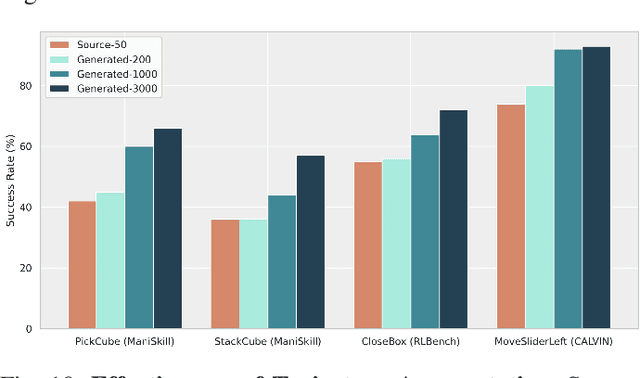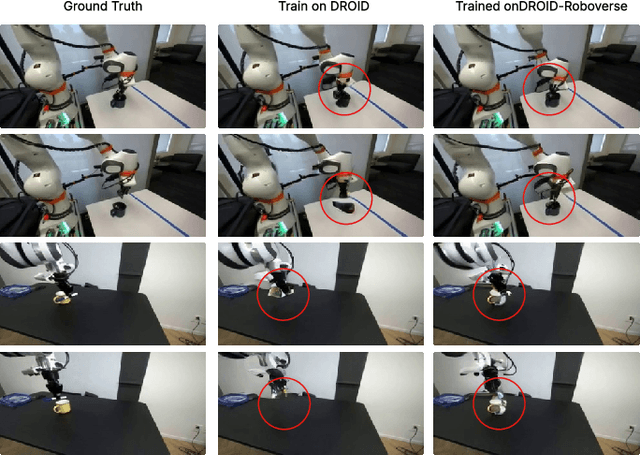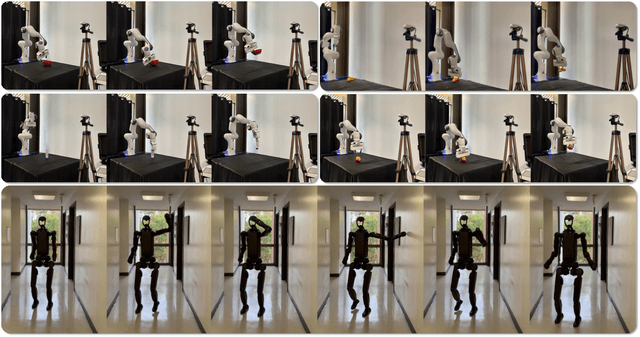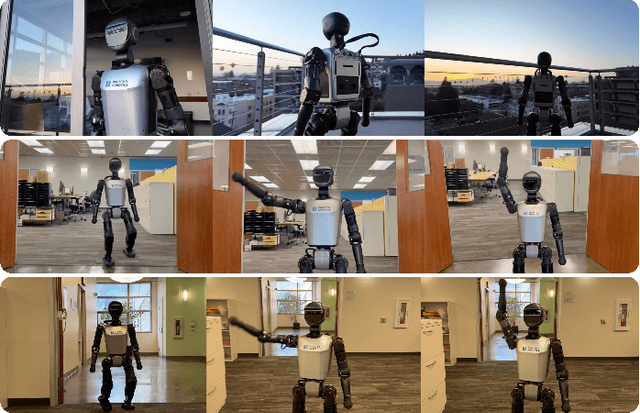Yuran Wang
From Scores to Preferences: Redefining MOS Benchmarking for Speech Quality Reward Modeling
Oct 01, 2025Abstract:Assessing the perceptual quality of synthetic speech is crucial for guiding the development and refinement of speech generation models. However, it has traditionally relied on human subjective ratings such as the Mean Opinion Score (MOS), which depend on manual annotations and often suffer from inconsistent rating standards and poor reproducibility. To address these limitations, we introduce MOS-RMBench, a unified benchmark that reformulates diverse MOS datasets into a preference-comparison setting, enabling rigorous evaluation across different datasets. Building on MOS-RMBench, we systematically construct and evaluate three paradigms for reward modeling: scalar reward models, semi-scalar reward models, and generative reward models (GRMs). Our experiments reveal three key findings: (1) scalar models achieve the strongest overall performance, consistently exceeding 74% accuracy; (2) most models perform considerably worse on synthetic speech than on human speech; and (3) all models struggle on pairs with very small MOS differences. To improve performance on these challenging pairs, we propose a MOS-aware GRM that incorporates an MOS-difference-based reward function, enabling the model to adaptively scale rewards according to the difficulty of each sample pair. Experimental results show that the MOS-aware GRM significantly improves fine-grained quality discrimination and narrows the gap with scalar models on the most challenging cases. We hope this work will establish both a benchmark and a methodological framework to foster more rigorous and scalable research in automatic speech quality assessment.
RobuSTereo: Robust Zero-Shot Stereo Matching under Adverse Weather
Jul 02, 2025Abstract:Learning-based stereo matching models struggle in adverse weather conditions due to the scarcity of corresponding training data and the challenges in extracting discriminative features from degraded images. These limitations significantly hinder zero-shot generalization to out-of-distribution weather conditions. In this paper, we propose \textbf{RobuSTereo}, a novel framework that enhances the zero-shot generalization of stereo matching models under adverse weather by addressing both data scarcity and feature extraction challenges. First, we introduce a diffusion-based simulation pipeline with a stereo consistency module, which generates high-quality stereo data tailored for adverse conditions. By training stereo matching models on our synthetic datasets, we reduce the domain gap between clean and degraded images, significantly improving the models' robustness to unseen weather conditions. The stereo consistency module ensures structural alignment across synthesized image pairs, preserving geometric integrity and enhancing depth estimation accuracy. Second, we design a robust feature encoder that combines a specialized ConvNet with a denoising transformer to extract stable and reliable features from degraded images. The ConvNet captures fine-grained local structures, while the denoising transformer refines global representations, effectively mitigating the impact of noise, low visibility, and weather-induced distortions. This enables more accurate disparity estimation even under challenging visual conditions. Extensive experiments demonstrate that \textbf{RobuSTereo} significantly improves the robustness and generalization of stereo matching models across diverse adverse weather scenarios.
DexGarmentLab: Dexterous Garment Manipulation Environment with Generalizable Policy
May 19, 2025Abstract:Garment manipulation is a critical challenge due to the diversity in garment categories, geometries, and deformations. Despite this, humans can effortlessly handle garments, thanks to the dexterity of our hands. However, existing research in the field has struggled to replicate this level of dexterity, primarily hindered by the lack of realistic simulations of dexterous garment manipulation. Therefore, we propose DexGarmentLab, the first environment specifically designed for dexterous (especially bimanual) garment manipulation, which features large-scale high-quality 3D assets for 15 task scenarios, and refines simulation techniques tailored for garment modeling to reduce the sim-to-real gap. Previous data collection typically relies on teleoperation or training expert reinforcement learning (RL) policies, which are labor-intensive and inefficient. In this paper, we leverage garment structural correspondence to automatically generate a dataset with diverse trajectories using only a single expert demonstration, significantly reducing manual intervention. However, even extensive demonstrations cannot cover the infinite states of garments, which necessitates the exploration of new algorithms. To improve generalization across diverse garment shapes and deformations, we propose a Hierarchical gArment-manipuLation pOlicy (HALO). It first identifies transferable affordance points to accurately locate the manipulation area, then generates generalizable trajectories to complete the task. Through extensive experiments and detailed analysis of our method and baseline, we demonstrate that HALO consistently outperforms existing methods, successfully generalizing to previously unseen instances even with significant variations in shape and deformation where others fail. Our project page is available at: https://wayrise.github.io/DexGarmentLab/.
Boosting Zero-shot Stereo Matching using Large-scale Mixed Images Sources in the Real World
May 13, 2025Abstract:Stereo matching methods rely on dense pixel-wise ground truth labels, which are laborious to obtain, especially for real-world datasets. The scarcity of labeled data and domain gaps between synthetic and real-world images also pose notable challenges. In this paper, we propose a novel framework, \textbf{BooSTer}, that leverages both vision foundation models and large-scale mixed image sources, including synthetic, real, and single-view images. First, to fully unleash the potential of large-scale single-view images, we design a data generation strategy combining monocular depth estimation and diffusion models to generate dense stereo matching data from single-view images. Second, to tackle sparse labels in real-world datasets, we transfer knowledge from monocular depth estimation models, using pseudo-mono depth labels and a dynamic scale- and shift-invariant loss for additional supervision. Furthermore, we incorporate vision foundation model as an encoder to extract robust and transferable features, boosting accuracy and generalization. Extensive experiments on benchmark datasets demonstrate the effectiveness of our approach, achieving significant improvements in accuracy over existing methods, particularly in scenarios with limited labeled data and domain shifts.
RoboVerse: Towards a Unified Platform, Dataset and Benchmark for Scalable and Generalizable Robot Learning
Apr 26, 2025



Abstract:Data scaling and standardized evaluation benchmarks have driven significant advances in natural language processing and computer vision. However, robotics faces unique challenges in scaling data and establishing evaluation protocols. Collecting real-world data is resource-intensive and inefficient, while benchmarking in real-world scenarios remains highly complex. Synthetic data and simulation offer promising alternatives, yet existing efforts often fall short in data quality, diversity, and benchmark standardization. To address these challenges, we introduce RoboVerse, a comprehensive framework comprising a simulation platform, a synthetic dataset, and unified benchmarks. Our simulation platform supports multiple simulators and robotic embodiments, enabling seamless transitions between different environments. The synthetic dataset, featuring high-fidelity physics and photorealistic rendering, is constructed through multiple approaches. Additionally, we propose unified benchmarks for imitation learning and reinforcement learning, enabling evaluation across different levels of generalization. At the core of the simulation platform is MetaSim, an infrastructure that abstracts diverse simulation environments into a universal interface. It restructures existing simulation environments into a simulator-agnostic configuration system, as well as an API aligning different simulator functionalities, such as launching simulation environments, loading assets with initial states, stepping the physics engine, etc. This abstraction ensures interoperability and extensibility. Comprehensive experiments demonstrate that RoboVerse enhances the performance of imitation learning, reinforcement learning, world model learning, and sim-to-real transfer. These results validate the reliability of our dataset and benchmarks, establishing RoboVerse as a robust solution for advancing robot learning.
DualToken: Towards Unifying Visual Understanding and Generation with Dual Visual Vocabularies
Mar 19, 2025Abstract:The differing representation spaces required for visual understanding and generation pose a challenge in unifying them within the autoregressive paradigm of large language models. A vision tokenizer trained for reconstruction excels at capturing low-level perceptual details, making it well-suited for visual generation but lacking high-level semantic representations for understanding tasks. Conversely, a vision encoder trained via contrastive learning aligns well with language but struggles to decode back into the pixel space for generation tasks. To bridge this gap, we propose DualToken, a method that unifies representations for both understanding and generation within a single tokenizer. However, directly integrating reconstruction and semantic objectives in a single tokenizer creates conflicts, leading to degraded performance in both reconstruction quality and semantic performance. Instead of forcing a single codebook to handle both semantic and perceptual information, DualToken disentangles them by introducing separate codebooks for high and low-level features, effectively transforming their inherent conflict into a synergistic relationship. As a result, DualToken achieves state-of-the-art performance in both reconstruction and semantic tasks while demonstrating remarkable effectiveness in downstream MLLM understanding and generation tasks. Notably, we also show that DualToken, as a unified tokenizer, surpasses the naive combination of two distinct types vision encoders, providing superior performance within a unified MLLM.
GarmentPile: Point-Level Visual Affordance Guided Retrieval and Adaptation for Cluttered Garments Manipulation
Mar 12, 2025Abstract:Cluttered garments manipulation poses significant challenges due to the complex, deformable nature of garments and intricate garment relations. Unlike single-garment manipulation, cluttered scenarios require managing complex garment entanglements and interactions, while maintaining garment cleanliness and manipulation stability. To address these demands, we propose to learn point-level affordance, the dense representation modeling the complex space and multi-modal manipulation candidates, while being aware of garment geometry, structure, and inter-object relations. Additionally, as it is difficult to directly retrieve a garment in some extremely entangled clutters, we introduce an adaptation module, guided by learned affordance, to reorganize highly-entangled garments into states plausible for manipulation. Our framework demonstrates effectiveness over environments featuring diverse garment types and pile configurations in both simulation and the real world. Project page: https://garmentpile.github.io/.
Ocean-OCR: Towards General OCR Application via a Vision-Language Model
Jan 26, 2025



Abstract:Multimodal large language models (MLLMs) have shown impressive capabilities across various domains, excelling in processing and understanding information from multiple modalities. Despite the rapid progress made previously, insufficient OCR ability hinders MLLMs from excelling in text-related tasks. In this paper, we present \textbf{Ocean-OCR}, a 3B MLLM with state-of-the-art performance on various OCR scenarios and comparable understanding ability on general tasks. We employ Native Resolution ViT to enable variable resolution input and utilize a substantial collection of high-quality OCR datasets to enhance the model performance. We demonstrate the superiority of Ocean-OCR through comprehensive experiments on open-source OCR benchmarks and across various OCR scenarios. These scenarios encompass document understanding, scene text recognition, and handwritten recognition, highlighting the robust OCR capabilities of Ocean-OCR. Note that Ocean-OCR is the first MLLM to outperform professional OCR models such as TextIn and PaddleOCR.
Baichuan-Omni-1.5 Technical Report
Jan 26, 2025Abstract:We introduce Baichuan-Omni-1.5, an omni-modal model that not only has omni-modal understanding capabilities but also provides end-to-end audio generation capabilities. To achieve fluent and high-quality interaction across modalities without compromising the capabilities of any modality, we prioritized optimizing three key aspects. First, we establish a comprehensive data cleaning and synthesis pipeline for multimodal data, obtaining about 500B high-quality data (text, audio, and vision). Second, an audio-tokenizer (Baichuan-Audio-Tokenizer) has been designed to capture both semantic and acoustic information from audio, enabling seamless integration and enhanced compatibility with MLLM. Lastly, we designed a multi-stage training strategy that progressively integrates multimodal alignment and multitask fine-tuning, ensuring effective synergy across all modalities. Baichuan-Omni-1.5 leads contemporary models (including GPT4o-mini and MiniCPM-o 2.6) in terms of comprehensive omni-modal capabilities. Notably, it achieves results comparable to leading models such as Qwen2-VL-72B across various multimodal medical benchmarks.
Mono2Stereo: Monocular Knowledge Transfer for Enhanced Stereo Matching
Nov 14, 2024



Abstract:The generalization and performance of stereo matching networks are limited due to the domain gap of the existing synthetic datasets and the sparseness of GT labels in the real datasets. In contrast, monocular depth estimation has achieved significant advancements, benefiting from large-scale depth datasets and self-supervised strategies. To bridge the performance gap between monocular depth estimation and stereo matching, we propose leveraging monocular knowledge transfer to enhance stereo matching, namely Mono2Stereo. We introduce knowledge transfer with a two-stage training process, comprising synthetic data pre-training and real-world data fine-tuning. In the pre-training stage, we design a data generation pipeline that synthesizes stereo training data from monocular images. This pipeline utilizes monocular depth for warping and novel view synthesis and employs our proposed Edge-Aware (EA) inpainting module to fill in missing contents in the generated images. In the fine-tuning stage, we introduce a Sparse-to-Dense Knowledge Distillation (S2DKD) strategy encouraging the distributions of predictions to align with dense monocular depths. This strategy mitigates issues with edge blurring in sparse real-world labels and enhances overall consistency. Experimental results demonstrate that our pre-trained model exhibits strong zero-shot generalization capabilities. Furthermore, domain-specific fine-tuning using our pre-trained model and S2DKD strategy significantly increments in-domain performance. The code will be made available soon.
 Add to Chrome
Add to Chrome Add to Firefox
Add to Firefox Add to Edge
Add to Edge